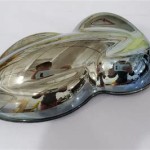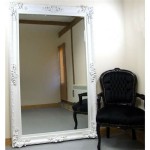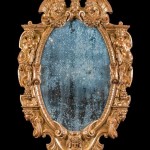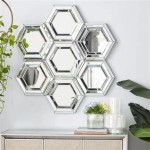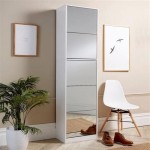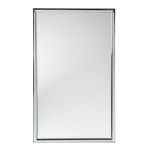How to Hang 3 Small Mirrors Together
Decorating with multiple small mirrors can add a unique, artistic touch to any space. Arranging and hanging three small mirrors together, however, requires careful planning and execution to achieve a visually pleasing and secure display. This article will outline the steps involved in successfully hanging three small mirrors together.
Planning the Arrangement: Before picking up a hammer, visualizing the final arrangement is crucial. Experiment with different layouts on a flat surface. Consider patterns such as a vertical line, a triangle, or a staggered arrangement. The chosen layout will influence the measurements and hardware required.
Measuring and Spacing: Once the desired arrangement is finalized, measure the overall dimensions. This includes the combined width and height of the mirrors, plus the desired spacing between them. Accurate measurements ensure the arrangement fits the chosen wall space and maintains visual balance.
Choosing the Right Hardware: Hardware selection depends on the weight of the mirrors and the wall material. For lighter mirrors, small picture hangers or adhesive strips might suffice. Heavier mirrors will require more robust hardware, such as D-rings and screws driven into wall studs. Consider the mirror frames as well; some frames have pre-installed hanging hardware.
Marking the Wall: Using the combined measurements from the planned arrangement, lightly mark the wall where the mirrors will hang. A pencil is recommended for easy removal of stray marks. Use a level to ensure horizontal and vertical alignment, especially for linear or geometric arrangements. Mark the location of each mirror's hanging points based on the hardware type.
Installing the Hanging Hardware: If using screws and wall anchors, drill pilot holes at the marked locations. This prevents the wall from cracking, especially with heavier mirrors. Insert the wall anchors and drive the screws, leaving enough of the screw exposed to hang the mirrors securely. For adhesive strips, ensure the wall surface is clean and dry before applying.
Preparing the Mirrors: If the mirrors don't have pre-installed hanging hardware, attach the chosen hardware to the back of each mirror frame. Ensure the hardware is securely fastened and positioned consistently across all three mirrors to maintain alignment when hung.
Hanging the Mirrors: Carefully hang each mirror on the installed hardware. Double-check the alignment and spacing between the mirrors to match the planned layout. A level can be used throughout the hanging process to maintain accuracy.
Utilizing Spacing Aids: For precise spacing between mirrors, consider using small spacers, such as coins or cardboard pieces. Place these spacers between the mirrors while hanging them to maintain consistent gaps. Once all mirrors are hung, the spacers can be removed.
Securing the Arrangement (Optional): For extra stability, especially in high-traffic areas, consider using small, clear bumpers or adhesive dots on the sides of the mirrors where they touch. This prevents them from shifting or knocking against each other.
Alternative Hanging Methods: For renters or those who prefer not to put holes in the wall, adhesive hooks designed for hanging pictures can be a viable alternative. Ensure the hooks are weight-rated for the combined weight of the three mirrors.
Choosing the Right Mirror Size and Shape: The size and shape of the mirrors will significantly impact the overall aesthetic. Small, circular mirrors can create a playful and whimsical feel, while rectangular or square mirrors offer a more modern and structured look. Consider the existing décor and the desired ambiance when selecting mirrors.
Working with Different Frame Types: The frames of the mirrors can be incorporated into the overall design. Matching frames create a cohesive and unified look, while contrasting frames can add an eclectic and dynamic touch. Frameless mirrors provide a minimalist and contemporary feel.
Incorporating Other Decorative Elements: Small mirrors can be combined with other decorative elements to create a more complex and layered wall display. Consider incorporating framed photos, small shelves, or wall sconces around the mirrors to enhance the visual interest.
Adapting to Different Wall Types: Different wall types require different hanging methods. Drywall is the most common and typically allows for a variety of hanging hardware. For plaster or concrete walls, specialized anchors and drills may be required. Consult hardware store professionals for advice on the appropriate hardware for specific wall types.
Troubleshooting Common Issues: One common issue when hanging multiple mirrors is uneven spacing. Double-check measurements and use spacers to maintain consistency. If a mirror hangs crooked, adjust the hanging hardware or use shims to level it. For adhesive strips that lose their grip, clean the wall surface and try a stronger adhesive.

Diy Set Of 3 Hanging Mirrors Decor8

Diy Set Of 3 Hanging Mirrors Passionshake

Grouping Mirrors On A Wall How To Decorate

How To Expand And Emphasize A Space With Decorative Mirrors

Mirrors On The Wall

51 Decorative Wall Mirrors To Fill That Empty Space In Your

Mirrors On The Wall

Set Of 3 Round Live Love Laugh Hanging Mirrors

Round Mirror Options Create Enjoy

10 Simple Ways To Decorate Around A Round Mirror Wikihow



